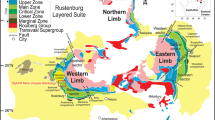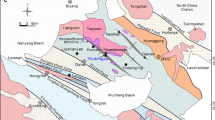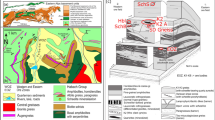Abstract
The White Trachytic Tuff (WTT) is a compositionally-zoned, trachytic, pyroclastic-flow deposit which erupted from Roccamonfina volcano about 300,000 years ago. It was principally emplaced as unwelded, pumice-rich flow units with an estimated volume of 10 km3. These now cover the flanks of the volcano on all sides except the west, behind the highest rim of Roccamonfina's summit caldera; the caldera was probably in existence prior to the WTT activity.
Eruption of the WTT generally initiated the leucite-free, second stage of Roccamonfina's development, following a long history of leucite-bearing volcanism, but minor leucite-bearing lavas and pyroclastics overlie the WTT as well. The WTT was in turn followed by progressively more basic, leucite-free magmas (latite, trachybasalt, and basalt). During the course of the eruption, the WTT evolved from white, crystal-poor pumices containing 66% SiO2 and 1.2% CaO, to grey pumices containing higher crystal contents, 60% SiO2, and 3% CaO. Early pumices are also relatively enriched in Mn, Na, Zn, Ga, Rb, Y, Zr, Nb, Cs, La, Ce, Yb, Lu, W, Hf, Th, and U, and depleted in Ti, Fe, Mg, K, Sc, V, Cr, Co, Sr, Ba, Nd, Sm, Eu, Tb, Dy, and Ta. The pumices are essentially bimodal in composition, with several minor intermediate types including megascopic, physical mixtures of the white and grey varieties. Certain WTT pumices, including all analyzed intra-caldera samples, are relatively enriched in Pb, Th, Zr, Rb, Ga, Zn, and Cs compared to the rest of the suite. These enrichments may reflect local assimilation of carbonates or more complex exchange processes at the magma chamber margin.
All WTT pumices contain the phases sanidine, plagioclase, clinopyroxene, biotite, titanomagnetite, sphene, and apatite; grey varieties also contain magnesian olivine crystals which are probably xenocrysts. The white, crystal-poor types show relatively simple mineralogies with little compositional variability or zoning among crystals of a single phase. Other pumice types, and dark, trachyandesitic inclusions separated from white pumices, show a large compositional spectrum of individually homogeneous crystals. These compositionally diverse crystals and inclusions are interpreted as a result of widespread mixing between the trachytic magmas and more basic magmas prior to or during the WTT eruption.
Major-element crystal-fractionation models can successfully derive the early trachytes from the late trachytes by 50–85% separation of a syenitic assemblage of all phases. The predicted phase proportions and compositions closely match cumulate syenite nodules found at Roccamonfina. Trace element models are permissive of syenitic fractionation within the large uncertainties allowed by published partition coefficients.
Similar content being viewed by others
References
Appleton JD (1972) Petrogenesis of potassium-rich lavas from the Roccamonfina Volcano, Roman Region, Italy: J Petrol 13 3:425–456
Arth JG (1976) Behavior of trace elements during magmatic processes — A summary of theoretical models and their applications: US Geol Surv Res 4, 1:41–47
Baldridge WS, Carmichael ISE, Albee AL (1981) Crystallization paths of leucite-bearing lavas: Examples from Italy: Contrib Mineral Petrol 76:321–335
Barberi F, Innocenti F, Lirer L, Munno R, Pescatore T, Santacroce R (1978) The Campanian Ignimbrite: a major prehistoric eruption in the Neapolitan area (Italy): Bull Volcanol 41:1–22
Barton M, Varekamp JC, Van Bergen MJ (1982) Complex zoning of clinopyroxenes in the lavas of Vulsini, Latium, Italy: Evidence for magma mixing: J Volcanol Geoth Res 14:361–388
Brooks CK, Printzlau I (1978) Magma mixing in mafic alkaline volcanic rocks: The evidence from relict phenocryst phases and other inclusions: Jour Volcanol Geoth Res 4:315–331
Carmichael ISE (1967) The iron-titanium oxides of salic volcanic rocks and their associated ferromagnesian silicates: Contrib Mineral Petrol 14:36–64
Carter SR, Evensen NM, Hamilton PJ, O'Nions RK (1978) Continental volcanics derived from enriched and depleted source regions: Nd- and Sr-isotope evidence: Earth and Planet Sci Lett 37:401–408
Civetta L, Innocenti F, Manetti P, Peccerillo A, Poli G (1981) Geochemical characteristics of potassic volcanics from Mts. Ernici (Southern Latium, Italy): Contrib Mineral Petrol 78:37–47
Clough BJ, Wright JV, Walker GPL (1981) An unusual bed of giant pumice in Mexico: Nature 289:49–50
Cornell WC, Sigurdsson H, Sparks RSJ (1979) The Campanian Ignimbrite of SW Italy: Eruptive phases and variations in glass chemistry: Trans Am Geophys Soc EOS 60, no 18, 409
Cortini M, Hermes OD (1981) Sr isotopic evidence for a multisource origin of the potassic magmas in the Neapolitan area (S. Italy): Contrib Mineral Petrol 77:47–55
Cortini M, Roberti N, Scandone R (1975) Geocronologia e paleomagnetismo del vulcano di Roccamonfina: Ann Geof 28:129–138
Cox KG, Hawkesworth CJ, O'Nions RK, Appleton JD (1976) Isotopic evidence for the derivation of some Roman Region volcanics from anomalously enriched mantle: Contrib Mineral Petrol 56:173–180
Devoto G (1965) Lacustrine Pleistocene in the lower Liri Valley (Southern Latium): Geologica Romana IV, 291–368
Di Girolamo P (1970) Differenziazione gravitativa e curve isochimiche nella ignimbrite Campana: Rand Soc It Min e Petr 26-2:547–588
Di Girolamo P, Keller J (1972) Zur Stellung des grauen Campanichen Tuffs, innerhalb des quartären Vulkanismus Campaniens (Sud Italien): Ber Natur Ges Freiburg 61-62:85–92
Drake MJ, Weill DF (1972) New rare earth element standards for electron microprobe analysis: Chem Geol 10:179
Falchi G, Tonani F (1974) Procedure rapide per l'analisi delle rocce: CNEN RT/GEO 64, 6, Roma
Fisher RV (1979) Models for pyroclastic surges and pyroclastic flows: J Volcanol Geoth Res 6:305–318
Ghiara MR, Lirer L, Stanzione L (1973) Contributo alla conoscenza vulcanologica e petrografica del vulcano di Roccamonfina: Per Min 42:267–293
Ghiara MR, Lirer L (1977) Mineralogy and geochemistry of the “low potassium” series of the Roccamonfina volcanic suite (Campania, South Italy): Bull Volcanol 41:39–56
Ghiara MR, Lirer L, Munno R (1979) Mineralogy and geochemistry of the “Low-potassium series” of the Campania volcanics (South Italy): Chemical Geology 26:29–49
Giannetti B (1979) The geology of Roccamonfina caldera (Campanian Province, Italy): Giornale Geologia ser 2:43:187–206
Giannetti B (1982) Cumulate inclusions from K-rich magmas, Roccamonfina volcano, Italy: Earth and Planet Sci Lett 57:313–335
Giannetti B, Nicoletti M, Petrucciani C (1979) Datazioni K-Ar di lave leucitiche dello strato-vulcano di Roccamonfina: Rend Soc It Mineral Petr 35:349–354
Gill JB (1978) Role of trace element partition coefficients in models of andesite genesis: Geochim Cosmochim Acta 42:709–724
Green TH, Ringwood AE (1968) Origin of garnet phenocrysts in calc-alkaline rocks: Contrib Mineral Petrol 18:163–174
Hawkesworth CJ, Vollmer R (1979) Crustal contamination versus enriched mantle: 143Nd/144Nd and 87Sr/86Sr evidence from the Italian volcanics: Contrib Mineral Petrol 69:151–165
Hildreth W (1977) The magma chamber of the Bishop Tuff: Gradients in temperature, pressure, and composition: Univ Calif Berkeley Unpubl Ph D dissert, 328 p
Hildreth W (1979) The Bishop Tuff: Evidence for the origin of compositional zonation in silicic magma chambers: Geol Soc Am Spec Paper 180:43–75
Hildreth W (1981) Gradients in silicic magma chambers: Implications for lithospheric magmatism: J Geophys Res 86, B11:10153–10192
Katsui Y (1963) Evolution and magmatic history of some Krakatoan calderas in Hokkaido, Japan: Jour Fac Sci, Hokkaido Univ, ser 4:11:631–650
Kouchi A, Sunagawa I (1982) Experimental study of mixing of basaltic and dacitic magmas: Tohoku Univ Sci Reports ser III, XV, no 2, 163–175
Lipman PW (1967) Mineral and chemical variations within an ashflow sheet from Aso caldera, southwestern Japan: Contrib Mineral Petrol 16:300–327
Lirer L, Pescatore T, Booth B, Walker GPL (1973) Two Plinian pumice-fall deposits from Somma-Vesuvius, Italy: Geol Soc Am Bull 84:759–772
Long PE (1978) Experimental determination of partition coefficients for Rb, Sr, and Ba between alkali feldspar and silicate liquid: Geochim Cosmochim Acta 42:833–846
Luhr JF, Carmichael ISE (1980) The Colima volcanic complex: I. Post-caldera andesites from Volcan Colima: Contrib Mineral Petrol 71:343–372
Mahood GA (1980) Geological evolution of a Pleistocene rhyolitic center — Sierra La Primavera, Jalisco, Mexico: J Volcanol Geoth Res 8:199–230
Masuda A, Nakamura N, Tanaka T (1973) Fine structures of mutually normalized rare-earth patterns of chondrites: Geochim Cosmochim Acta 37:239–248
Michael PJ (1983) Chemical differentiation of the Bishop Tuff and other high-silica magmas through crystallization processes: Geology 11:31–34
Perlman I, Asaro F (1969) Pottery analysis by neutron activation: Archaeometry 11:21–52
Simmons EC, Hedge CE (1978) Minor-element and Sr-isotope geochemistry of Tertiary stocks, Colorado Mineral Belt: Contrib Mineral Petrol 67:379–396
Sparks RSJ, Self S, Walker GPL (1973) Products of ignimbrite eruptions: Geology, Nov 115–118
Taylor Jr, HP, Giannetti B, Turi B (1979) Oxygen isotope geochemistry of the potassic igneous rocks from the Roccamonfina volcano, Roman Comagmatic Region, Italy: Earth and Planet. Sci Lett 46:81–106
Thompson RN (1977) Primary basalts and magma genesis — III. Alban Hills, Roman Comagmatic Province, Central Italy: Contrib Mineral Petrol 60:91–108
Varekamp JC (1980) The geology of the Vulsinian area, Lazio, Italy: Bull Volcanol 43-3:487–503
Vollmer R, Hawkesworth CJ (1980) Lead isotopic composition of the potassic rocks from Roccamonfina (South Italy): Earth Planet Sci Lett 47:91–101
Vollmer R, Johnston K, Ghiara MR, Lirer L, Munno R (1981) Sr isotope geochemistry of megacrysts from continental rift and converging plate margin alkaline volcanism in south Italy: J Volcanol Geoth Res 11:317–327
Williams H (1942) The geology of Crater Lake National Park, Oregon, with a reconnaissance of the Cascade Range southward to Mount Shasta: Carnegie Inst Washington Publ 540:162 p
Wright TL, Doherty PC (1970) A linear programming and least squares computer method for solving petrologic mixing problems: Geol Soc Am Bull 81:1995–2008
Yamasaki M (1958) Notes on rock-forming minerals — 2. Garnets from volcanic rocks: J Geol Soc Jpn 64, no 758:601–604
Author information
Authors and Affiliations
Rights and permissions
About this article
Cite this article
Giannetti, B., Luhr, J.F. The white trachytic tuff of Roccamonfina Volcano (Roman Region, Italy). Contr. Mineral. and Petrol. 84, 235–252 (1983). https://doi.org/10.1007/BF00371289
Received:
Accepted:
Issue Date:
DOI: https://doi.org/10.1007/BF00371289




